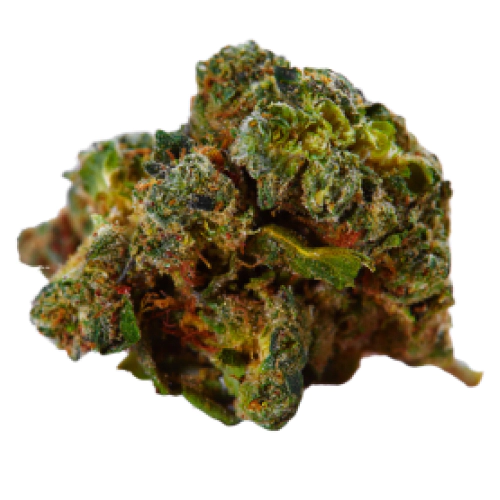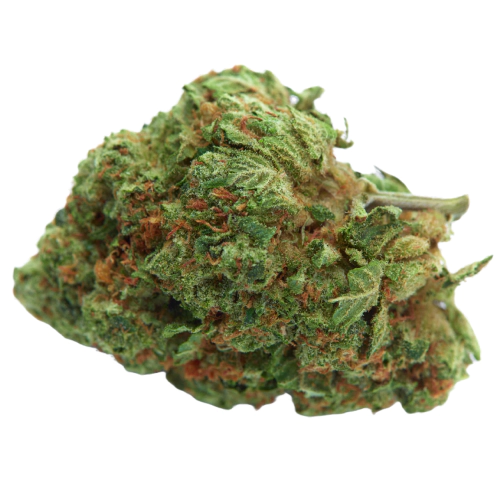THC 15.5 - 19.5%
CBD 0.27 - 0.86%
Effect Giggly
Flavor Apricot
22.25 - 26.25%
0.52 - 0.91%
0.2 - 0.75%
Pine, Grape
Relaxed
501st OG strain was created by Rare Dankness in the USA. It is quite popular and can be found almost everywhere, where cannabis is legal. It was bred by crossing Skywalker OG and Rare Dankness 1.
The weed buds are olive green, but with shades of purple and blue. Strains have a wide variety of flavors, but they work well. They appear due to the presence of terpenes ocimene, sabinene, humulene, nerolidol. Also, smokers most often talked about such tastes:
THC levels average 24%, CBD 0.6%. At the same time, the 501st OG strain side effects can be called insignificant, these are anxiety and dizziness, which do not appear often. Because of this, clients use 501st OG to treat:
The 501st OG weed strain high begins with euphoria and happiness. Talkativeness appears, but you should be careful because you will most likely start giggling as well. Happiness is also equated with the calmness of the body. Smokers often talked about relaxation, which, however, did not put them to sleep, but on the contrary, awakened them. Therefore, it is better to consume this kush in the afternoon, but not in the evening.
Growing a 501 OG strain will suit even a beginner as the plant yields 2-4 oz/ft square. It feels best indoors, with a flowering time of 8-9 weeks. However, it is up to 30 inches, making it suitable for growing in confined spaces.
| THC | Tetrahydrocannabinol, or THC, is a major cannabis chemical compound. It is a psychoactive element that stimulates dopamine release and induces euphoria or happiness. THC-rich strains may be helpful with such conditions as lack of appetite, chronic pains , etc. It is considered to be the primary active marijuana component. | 22.25 - 26.25% |
| CBD | Cannabidiol, or CBD, is a major compound in cannabis, which is non-psychoactive. It is also proved to counteract the side effects of the second major component THC. CBD is widely used for medicinal purposes in rubs, oils and so on. It is helpful in muscle pain cases, may treat arthritis and migraines. Even Greeks used it against pain, while Queen Victoria applied it to get rid of menstrual cramps. | 0.52 - 0.91% |
| CBC | Cannabichromene, or CBC, is a minor cannabinoid, meaning that its quantity in cannabis is quite little. Though it has the same origin as CBD and THC, it is different in functions. Without any psychoactive effects, it is an efficient cannabis compound in combating acne and depression. CBC produces analgesic, antibacterial and anti-inflammatory effects. | 0.26 - 0.5% |
| CBG | Cannabigerol, or CBG, is one of the minor cannabis compounds in adult plants. On the other hand, young ones contain a lot of this antibacterial and anti-inflammatory component. During the growth, CBG is converted into different cannabinoids, mostly THC and CBD. The compound itself increases appetite and decreases eye pressure. | 0.2 - 0.75% |
| CBN | Cannabinol, or CBN, is a trace element in cannabis that is considered to be mildly psychoactive. It appears from oxidation THC, exposed to light and heat. CBN is mostly contained in old cannabis and in traditional hashish. It is effective against insomnia, bacterial infections and appetite loss. | 0.04 - 0.25% |
| THCV | Tetrahydrocannabivarin, or THC-V, is a compound contained in cannabis in trace amounts. Even though it is close to THC molecularly, it is different in effects. This compound may be psychoactive only in large amounts. THC-V reduces blood sugar, controls appetite, stimulates bone growth, etc. African Sativa strains are the richest in THC-V. | 0.15 - 0.48% |
| Pinene | Pinene is one of the most widespread terpenes in nature, found in pine trees, basil, nutmeg, parsley, and rosemary. Cannabis containing terpene (alpha-pinene or α-pinene) boasts a strong pine scent. Pinene is responsible for anti-inflammatory, pain-relieving, and anti-anxiety effects. | 0.04% |
| Myrcene | Myrcene (also known as β-myrcene) is one of the most common terpenes found in cannabis, representing more than 20% of the modern marijuana terpene profile. Myrcene has a distinct earthy, musky flavor, resembling cloves. It is responsible for calming and soothing effects of weed. Myrcene is also found in hops, thyme, mango, lemongrass, guava melon. | 0.18% |
| Ocimene | Ocimene (derived from the Ancient Greek word Ocimum meaning basil) is a terpene with sweet and herbaceous flavors, also boasting citrusy and woody undertones. Naturally, ocimene occurs in mint, parsley, orchids, hops, kumquats, mangoes, basil, bergamot, lavender, and pepper. Offers antifungal, anti-inflammatory, and antiviral properties. | 0.15% |
| Humulene | Humulene (also known as α-humulene) is one of the major terpenes found in cannabis, contributing to woody, earthy, spicy, herbaceous, and, mainly, floral aromas of cannabis. Used in modern medicine, humulene offers anti-inflammatory, antibacterial, and appetite suppressant effects, which have been well-researched by pharmaceutical companies. | 0.09% |
| Limonene | Limonene (also known as d-limonene) is the second most common terpene in nature and the third most common terpene in cannabis. It has a powerful citrus aroma and can be found in all citruses, including lemons, oranges, grapefruits, limes, juniper, etc. Limonene is known to elevate moods and provide anxiety, depression, and stress relief. | 0.15% |
| Linalool | Linalool (also known as beta linalool, linalyl alcohol, linaloyl oxide, and p-linalool) is one of the rarest terpenes found in cannabis, mostly in small quantities. Linalool is known for its spicy and lavender aroma, bringing relaxation and calming effects. It is also said to provide anti-inflammatory and analgesic properties that can be useful for athletes. | 0.06% |
| Sabinene | Sabinene is a terpene with a peppery, spicy, citrusy, and piney aroma, presented in Norway spruce, Holm oak trees, black pepper, cardamom, and carrot seeds. Found in cannabis in small quantities. Allegedly, sabinene has anti-inflammatory and antimicrobial properties. | 0.13% |
| Nerolidol | Nerolidol (also known as trans-nerolidol) is a terpene found in jasmine, tea tree, and lemongrass, as well as in some cannabis strains. Nerolidol has a distinguished floral aroma with notes of citrus, apples, and rose. The terpene has sedative, anti-anxiety, antimicrobial, anti-parasitic, anti-oxidant, and pain-relieving properties. | 0.07% |
| Terpinolene | Terpinolene is one of the most common terpenes found in cannabis; however, It's usually presented in small quantities. Is responsible for piney, floral, herbaceous, and even a little bit citrusy aroma of cannabis. Terpinolene can be found in lilacs, nutmeg, and cumin. In cannabis, terpinolene contributes to the sensation of "freshness." Has the potential to reduce the risk of heart diseases. | 0.01% |
| Caryophyllene | Caryophyllene (also known as beta or b caryophyllene) is a terpene found in many herbs and spices, such as black pepper, basil, rosemary, and oregano. Cannabis high in caryophyllene delivers a strong spicy, peppery aroma, resembling cinnamon and cloves. Caryophyllene offers potent anti-inflammatory and sedative effects. | 0.14% |
| Total terpenes content | 1.02% |
THC 15.5 - 19.5%
CBD 0.27 - 0.86%
Effect Giggly
Flavor Apricot
THC 16.5 - 17.5%
CBD 0.72 - 0.68%
Effect Giggly
Flavor Lime
THC 19 - 22.5%
CBD 0.16 - 0.95%
Effect Sleepy
Flavor Lime
THC 25.33 - 29%
CBD 0.42 - 0.75%
Effect Uplifted
Flavor Spicyherbal
THC 9.67 - 7%
CBD 11.05 - 11.4%
Effect Happy
Flavor Tobacco

THC 19 - 22.5%
CBD 1.04 - 1.18%
Effect Uplifted
Flavor Lemon
THC 19 - 20.67%
CBD 0.14 - 0.39%
Effect Happy
Flavor Sweet
THC 17 - 22.5%
CBD 0.4 - 0.7%
Effect Relaxed
Flavor Berry
THC 20.5 - 23.5%
CBD 2.43 - 2.62%
Effect Euphoric
Flavor Blueberry
THC 20.2 - 22.4%
CBD 0.21 - 0.5%
Effect Uplifted
Flavor Tropical
THC 15.17 - 17.67%
CBD 0.41 - 0.64%
Effect Happy
Flavor Citrus

THC 17.25 - 20%
CBD 0.16 - 0.49%
Effect Relaxed
Flavor Berry

THC 15.4 - 17%
CBD 0.52 - 0.68%
Effect Aroused
Flavor Spicyherbal
THC 18 - 21.25%
CBD 0.18 - 0.48%
Effect Relaxed
Flavor Pine
THC 15.5 - 21.83%
CBD 0.35 - 1.01%
Effect Uplifted
Flavor Sweet
THC 22.75 - 24%
CBD 0.31 - 0.51%
Effect Hungry
Flavor Spicyherbal
THC 8 - 13%
CBD 0.02 - 0.15%
Effect Energetic
Flavor Tropical
THC 25 - 26%
CBD 0.54 - 0.73%
Effect Euphoric
Flavor Strawberry
THC 18.67 - 20.67%
CBD 0.57 - 0.92%
Effect Sedated
Flavor Mango
Be the first and share your opinion
Write a Review